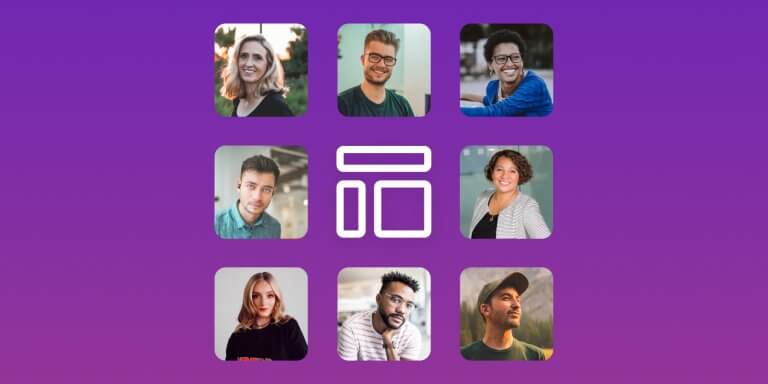Table of Contents
If you’ve been coaching clients through 1:1 sessions and are ready to offer something more structured, scalable, and impactful, this blog post is for you.
Creating your own signature coaching program is a practical way to grow your entire coaching business while delivering deeper transformation for your ideal clients. Instead of repeating yourself session after session, you’ll have a clear process, tools, and curriculum to guide multiple clients toward real results.
In this article, you’ll learn how to create a coaching program from the ground up, whether you’re just getting started or updating an existing offer. I’ll walk you through planning your curriculum, choosing a delivery format, packaging your offer, and finding your first few clients.
Before we dive in, here’s a valuable resource to get you started. Download LearnWorlds’ Coaching Program Templates for free. You’ll gain access to ready-made course outlines and content frameworks provided in the templates, which give you a clear blueprint for organizing your programs and scaling your business.
What is a coaching program?
A coaching program is a structured, goal-oriented experience that guides individuals, or groups, through a process of growth and change. Whether you’re focused on business, leadership, mindset, or personal development, it’s more than a series of sessions. It’s a designed journey with a beginning, middle, and end.
What sets it apart from ad-hoc sessions is the clarity around program structure, the inclusion of repeatable coaching exercises, and a clear link between each phase and the client’s goals.
A well-built online coaching program creates consistency in delivery while allowing space for personalization based on your coaching style and your client’s objectives. It also gives you, as a coach, the ability to serve both you and your clients better, without starting from scratch every time.
Key benefits of structured coaching programs
When delivered through a professional platform like LearnWorlds, your online coaching program can integrate interactive content, assessments, and tracking to streamline the entire coaching journey, for both coach and client.
Why create a coaching program?
If you’re offering 1:1 sessions without a clear structure, it’s easy to lose momentum, both for you and your clients. A structured coaching program changes that.
It gives you a scalable way to deliver your coaching services, reach more new clients, and guide people toward lasting results. Instead of re-creating each session from scratch, you work from a consistent coaching plan that reflects your values, tools, and method.
For clients, the transformation is tangible. Clear goals, measurable progress, and access to consistent coaching materials make the experience feel more professional and personalized. It’s the difference between casual check-ins and a real commitment to personal growth.
Benefits for you as a coach
Benefits for your clients
A strong coaching program doesn’t replace the coaching relationship, it strengthens it. With platforms like LearnWorlds, you can manage everything in one place, from hosting sessions to tracking progress and gathering client feedback for long-term client satisfaction.
Identify your niche and your client goals
Before you build any program content, you need to get clear on who it’s for, and what results they care about. Your target audience should shape everything from your messaging to your curriculum.
The more specific your niche, the easier it is to design a coaching experience that resonates. When you know what your potential clients are struggling with, what they’ve tried before, and what motivates them, you can create a program that truly speaks to their needs.
Questions to help you define your coaching plan
Your program isn’t just about delivering sessions, it’s about guiding someone through a full coaching journey. From discovery to results, your offer becomes the bridge between where they are and where they want to go.
A few niche & goal examples
The more aligned your offer is with your client’s objectives, the more likely you are to attract clients who are ready to commit, and get results.
When you use a platform like LearnWorlds, you can even invite clients into different tracks based on their goals and segment your audience for a more personalized coaching relationship.
Choose your format and program delivery method
Now that you’ve defined who your program is for and what outcomes you’ll help them achieve, it’s time to decide how you’ll deliver it.
The right program delivery format depends on your target audience, your capacity, and the level of support needed to drive results. Whether you prefer the intimacy of 1:1 sessions or the scalability of a group coaching program, your structure should align with your coaching style and client goals.
Coaching formats to consider
Factors to guide your format
How LearnWorlds supports your delivery
With LearnWorlds, you can build and run your online coaching program without needing to piece together different tools:
Whether you’re offering live, blended, or fully digital coaching services, your delivery method should make learning feel seamless, and scalable.
Design your coaching curriculum and tools
Your curriculum is the backbone of your program. It’s what takes clients from confusion to clarity, from stuck to moving forward. A well-structured curriculum breaks down the transformation into achievable milestones, helping you guide people through an intentional coaching journey.
Think of your curriculum as the roadmap behind your coaching plan. It aligns your expertise with your client’s objectives and ensures every session has a purpose.
Key elements of your curriculum
You don’t need to overload your program with content. Focus on quality over quantity. Each part of your curriculum should support active participation and move the client closer to their goal.
Tools to support your curriculum
Coaching tools help turn ideas into action. These don’t just add value, they make your program easier to teach and repeat.
Consider including:
Each of these tools gives your clients valuable insights and keeps your curriculum focused on desired outcomes.
Build and host your curriculum with LearnWorlds
LearnWorlds helps you turn ideas into a professional, branded program:
Whether your program is 100% live, fully self-paced, or somewhere in between, LearnWorlds supports the structure, delivery, and evolution of your curriculum.
If you want a head start, our free coaching program templates include done-for-you worksheets and templates to plug directly into your modules.
Name, package & price your coaching program
Your coaching program is only as effective as your ability to communicate its value. A strong name, a well-thought-out pricing strategy, and a clear package make it easier to attract clients, especially when you’re serving multiple audience segments or launching to new clients.
Name your coaching program clearly
Avoid vague or overly clever names. Go with something specific, outcome-focused, and aligned with your niche.
Few examples:
A good name immediately tells your target audience who the program is for and what transformation it delivers.
Package your offer intentionally
When it comes to packaging, think in layers:
Offering tiered options can help serve both existing clients and newcomers at different commitment levels.
Pricing models that work for coaches
Using a platform like LearnWorlds makes it easy to test different pricing models, offer coupons or bundles, and track how clients engage across offers.
Boost value with extras
You don’t need to overdeliver, but offering smart bonuses helps increase perceived value and client satisfaction. Try adding:
When you structure and price your offer well, it becomes easier to market, deliver, and scale.
Launch and market your coaching program
A great program means nothing if no one knows about it. Once your offer is ready, it’s time to focus on promotion, so you can invite clients, test your messaging, and grow your coaching practice.
The good news? You don’t need a massive following or a complex funnel to launch. You just need clarity, a defined target audience, and a simple system for showing people how your program helps.
Start with a simple, client-focused launch
Launching isn’t about hype. It’s about relevance and connection. Show how your program aligns with your client’s objectives, and the transformation you’ll guide them through.
Marketing assets to prepare
Platforms like LearnWorlds help you launch faster with:
Don’t forget post-launch
After launch, continue building visibility with content that supports your niche:
This positions you as a go-to expert and fills your pipeline with potential clients, even between launches.
Gather feedback & improve your program
A coaching program isn’t something you create once and forget. The best programs evolve over time, guided by real data, client insights, and your own growth as a coach.
Once you’ve launched, it’s critical to pause, review, and refine. This ensures your coaching services stay relevant, effective, and aligned with what your clients actually need.
How to gather feedback that matters
Platforms like LearnWorlds make this easy by giving you built-in feedback forms, quiz reports, and completion analytics, so you can review patterns and make confident improvements.
What to look for in feedback
When in doubt, ask about the coaching experience. The answers often reveal how aligned your delivery is with your promises, and where to iterate next.
Small changes that lead to big impact
Remember, every round is a chance to improve retention, completion, and client satisfaction, which also leads to more referrals and higher-impact testimonials.
Free coaching program templates you can use right away
Building your first program? Don’t start with a blank page. We’ve created four complete, plug-and-play templates to help you structure, price, and deliver your coaching offer faster, without sacrificing quality.
These templates are based on proven frameworks used by top LearnWorlds coaches and consultants.
What’s included in the free templates
You get access to 4 complete coaching program blueprints:
Each template includes suggested content formats (videos, workbooks, assessments, diaries), pricing ideas, and a clear course structure, from welcome videos to wrap-up and certificates.
Whether you’re building a new program or refining your signature program for existing clients, these templates help you create repeatable results and save hours of setup.
Scale your coaching practice with LearnWorlds
Once your program is validated, it’s time to think beyond your first launch. A successful coaching program isn’t just a one-time offer, it can become a repeatable system, a product suite, or even a licensing opportunity.
Whether you’re coaching part-time or building a full sustainable business, the right platform helps you scale without sacrificing personalization or quality.
Ways to scale your coaching services
Scaling doesn’t always mean “bigger,” sometimes it means smarter. Automate where it makes sense. Stay live where it adds value. Use tech to amplify, not replace, your unique coaching style.
How LearnWorlds supports growth
As you grow, so do your needs. LearnWorlds is built to scale with you, from your first beta to a full library of training programs.
Ready to build your coaching program?
You don’t need a huge team, fancy tools, or a massive following to build a successful coaching business. What you need is a clear offer, a repeatable structure, and the right tools to deliver a standout experience.
Whether you’re just starting out or scaling your coaching practice, a structured program helps you support more people, without burning out. With LearnWorlds, you can build, deliver, and grow your online coaching program all in one place.
From branded landing pages and course builders to live sessions, content hosting, and built-in analytics, it’s everything you need to create an effective, engaging, and scalable offer.
Start your 30-day free trial and see how easy it is to create, sell, and deliver your own signature coaching program, all in one place.
Rosemary is LearnWorlds’ Content Marketing Manager. She has over 2 decades of experience in omnichannel marketing and content writing for the IT and SaaS industry. Her expertise lies in crafting effective content marketing strategies that attract, engage, and nurture customers, enabling LearnWorlds to reach its target audiences with precision.
FAQ
Everything you have ever wondered, but were too afraid to ask...


